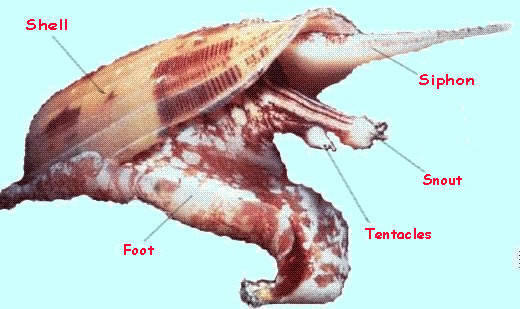|
The layman may simply feel them as cute, whereas t collector admires the very variant-rich, filigree color reviews of the porcelain like shells of the cone snail-snails. Different brighter basic colorings and multi-faceted variant-rich drawings with mostly brown and black grids, stripes, spots, spots or shadings make it not easy even for experts to determine the different species. Furthermore, cone snails in free nature are often encrusted with algae or moss or buried also in the sand, facts which do not facilitate the identification Worldwide there are supposed to be more than 500 species of cone-snails. Roughly, half of the species is to be encountered in the intertidal waters of the Philippines - and here in particular on Bohol and Cebu.
But here we dont want to refer to the beauty of cone snails but to her potential danger. In doing this we have to look for the physique and the hunting behaviours of the snails. Body and injection mechanism The basic form of the cone snail shells is to a large extent identical: a regular, straight-sided conical shape with a tapering body whorl and a quite flat, sometimes bumpy spire and an oblong, slot-shaped aperture.
At the narrow side of the shell you can see a little rounded aperture, from which a siphon (breath tube) can be extended. With help of the siphon oxygen water can be transported into the gills even when the shell is buried in the sand. The siphon has chemo receptors indicating the neighborhood of possible prey. The snail can withdraw her foot into the shell. In the interior of the shell we find the viscera sack and other inner organs like liver, lung, and kidneys. A thin mantle covers the body and lines the inside of the shell. Cone snails have a longer muscular foot which is used for the slow, wavelike moving. The foot carries on the back the dagger-like operculum on the back side (broader side of the shell. In case of a withdrawal of the snail the operculum locks the access. In the foot there is an organ of equilibrium and localisation. It is filled with bubbles, which contain calcium-carbonate-granules. The pressure of the granules is transmitted to nerves cells. On the narrower side of the shell the foot, which has a lot of mucous glands, merges into the head. The head has eyes and two tentacles as a sense for touch. Let's now come to the most significant organ of the cone snail, the distensible snout (proboscis). Often only the proboscis looks out of the sand and imitates a worm. Conus snails are nocturnal predatory animals, that pursue other molluscs, worms, small fishes or the own family. During evolution, they changed their radula teeth into little hollow poison-filled harpoons, which are provided with barbs and can reach a length of one centimetres. The harpoons are in a kind of sack and each of them is connected with a poison gland. They are exchangeable and can be recharged by reserve harpoons. A special muscle can shoot the poison harpoon in the direction of the prey. Often the death of the prey occurs within seconds after the injection of the poison cocktail. The poison harpoon is shot with a thread. So the cone snail remains tethered with the prey. After having trailed the paralyzed prey to its snout and the snail extends the proboscis like a snake. It envelops the prey, which can reach the own size and the digestion is beginning. The poisonous darts are also used for defense. There is only a small knowledge about the life-cycle of the cone snails. In a opened capsule of a "Conus textile!" there have been found 500 - 700 eggs. We can suppose that only very few reach an adult stage. Encountering cone snails
Cone snails can be found in the reef and coastal areas especially in time of low tide. In principle, all species can inject poison. But the poison dose of the large majority of the round about 500 species is too weak to endanger man. Such snails that feed on worms have the weakest poison. Dangerous for man however, are the larger species which are hunting small fishes (piscivorous species). They can cause strong pains and their toxins can be lethal also for humans. Special care is necessary with regard to the l "Conus geographus", which is classified as most dangerous because of its very strong venom cocktail. Its shell shows map-like markings. Sometimes it is also called cigarette-snail because it is told that after the stitch there is only the time to smoke a cigarette before passing away. Hanewald is writing that in the Philippines all certified deaths are caused by this sea snail.(1) l "Conus textile" with a pointed spire, white background and many small and large overlapping angle signs. There is another author writing that at least two deaths have been associated with the conus textile (2). l "Conus striatus": Shell with fine spirals-lines l Conus aulicus", which can be found in particular on Samar l and the thin shaped "Conus tulipa" ,which has a broader shoulder ramp The puncture mark is often very small, deep and three-angled. The descriptions of the physical conditions after the prick differ a little bit because the cocktail of venom peptides can have both inhibitory paralyzing and excitatory cramping effects depending on which muscle nerves have been targeted. In this context we should mention again, that many encounters cause pains for some hours, but not run fatally. The following symptoms have been described:
Which precautions should be taken? If one finds cone snails in the reef, caution is necessary. Also for specialists it is difficult to distinguish the dangerous snails from the harmless ones. Even the same species can vary partially with regard to its external appearance. If the wish for collecting prevails, then it is recommended to hold the animal on the widest point. The use of tongs is better. And never put the living animal into your trouser pocket. In case of sting-injection there are no specific emergency measures and no antidote exists. A general help could be: ligature of the affected limb, the immersion of the limb into very cold or very hot water, artificial respiration in case of respiratory paralysis and immediate medical consultation. Cone snail poisons in the focus of the drug research It was in particular the Philippine biochemist and neurologist Baldomero Olivera, who began in the late sixties to analyze the complex poison cocktail especially from the species "Conus geographus". His goal was the fractioning and synthesizing of the peptides and conotoxins in order to get better drugs. Why synthesizing? Thats because the natural stock of conus snails would have never sufficed to produce adequate quantities of drugs. And no one could justify such a severe intervention into the biotopes. The analysis showed astonishing results. Every species of cone snail has a complex of about 100-200 poison peptides. They differ from species to species, so an enormous depot of different peptides could be screened. In the meantime, researchers isolated a sequence of more than 1000 toxins and round about hundred toxins have been manufactured chemically. Especially the neurotoxin SNX 111, which is in clinical investigation stage III, raises hopes. It is as painkiller, which is thousand times stronger than morphine, but it has not the side effects of morphine (drug addiction and tolerance development). It could be used in treatment of chronic pains the final stage of cancer and Aids. Now many other pharmaceutical laboratories are researching further possible applications (i.e. treatment of mental illnesses and neurodegenerative diseases). It seems that until now the highly effective poison peptides have not found entry into the production of bio weapons. Nevertheless, Gary Stix (3) reports that the Russian military in time before president Jelzin tried to insert a fatal poison peptide of the "Conus geographus" into a small pocks virus. The experiments are supposed to have been unsuccessful, but underline the enormous poison potential of some cone snails. (1) Roland Hanewald, Philippinen Abenteuer-Handbuch, Bremen, 1996, pp. 222/223 (2) http://http://www.weichtiere.at/Mollusks/schnecken/meer/kegel.htm (3) Gary Stix in American Scientific, April 2005, 70-75 © Wolfgang Bethge, 2005 |


